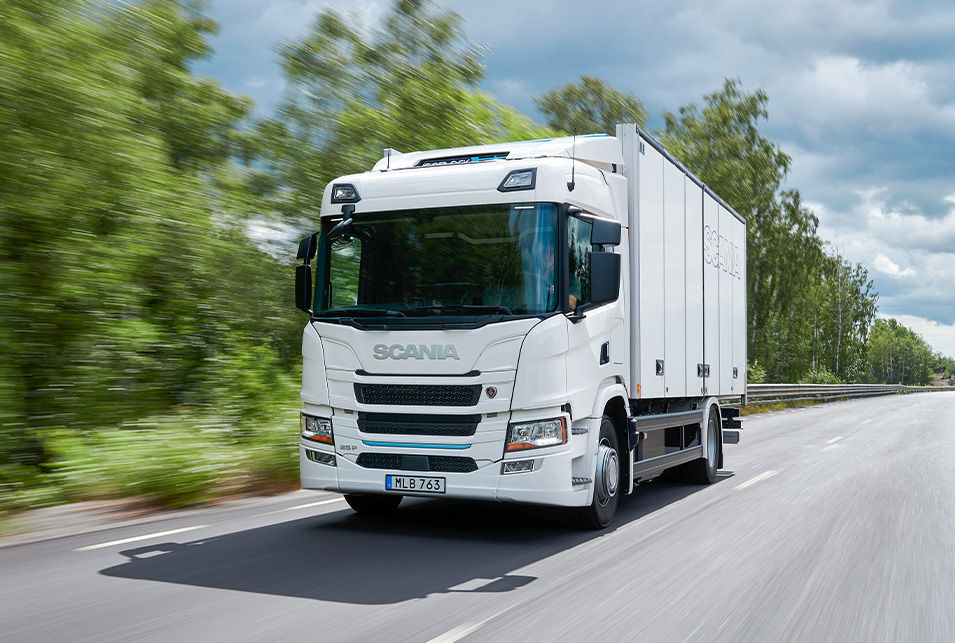Scania

Scania unveiled its first fully electric truck in 2020, underpinning its position as one of the leading companies in the commercial vehicle industry for alternative drive technologies.
BUSINESS DEVELOPMENT
The Swedish brand Scania follows its values “Customer first”, “Respect for the individual”, “Elimination of waste”, “Determination”, “Team Spirit” and “Integrity”. In rolling out its first fully electric truck, Scania underpinned its position as one of the leading companies in the commercial vehicle industry for alternative drive technologies in 2020. Scania’s E-Truck was designed for urban operation and has an electric range of up to 250 km. In the reporting year, Scania also presented a hybrid truck with an electric range of up to 60 km. The new products will help Scania achieve its climate targets of reducing the carbon footprint from its business activities by 50% by 2025, and cutting emissions from Scania products by 20% in the same period. Vehicles with hydrogen technology are also playing their part: the Norwegian wholesaler ASKO is currently testing hydrogen-powered Scania trucks with fuel cell electric drives.
To electrify its model range, Scania plans to invest well over SEK 1 billion in a battery assembly plant in Södertälje, Sweden, in the coming years. The plant, which will be built adjacent to the chassis assembly plant in Södertälje, is to assemble battery modules and packs tailored to Scania vehicles.
To gain a firmer foothold in the Asian and especially the Chinese market, Scania is investing in a wholly owned truck production facility in Rugao in Jiangsu Province. Series production is scheduled to start in early 2022. In the long term, the company also plans to step up its research and development activities in the world’s largest commercial vehicle market.
The key figures presented in this chapter encompass Scania’s truck and bus, industrial and marine engine businesses.
Orders received at the Scania brand increased by 4.7% year-on-year to 93 thousand vehicles in fiscal year 2020. The number of vehicles delivered worldwide fell to 72 (99) thousand due to the pandemic; the number of buses delivered included in this figure declined to 5 (8) thousand units. Demand for services and replacement parts was also impacted by the Covid-19 pandemic, but the drop was comparatively smaller. New contracts signed at Scania Financial Services were also down on the prior-year figure, due mainly to lower unit sales.
Scania manufactured 73 (97) thousand commercial vehicles in the past fiscal year, including 5 (8) thousand buses.
SALES REVENUE AND EARNINGS
Scania Vehicles and Services generated sales revenue of €11.5 (13.9) billion in fiscal year 2020. Operating profit fell by 50.3% to €0.7 billion owing to the pandemic and exchange rate effects; in addition, steps were taken to realign the production facilities. A favorable product mix and cost savings had a positive effect. The operating return on sales amounted to 6.5 (10.8)% in the reporting period.
4.7%
Increase in orders received
PRODUCTION |
||||
|---|---|---|---|---|
Units |
2020 |
2019 |
||
|
|
|
||
Trucks |
67,106 |
89,276 |
||
Buses |
5,430 |
7,719 |
||
|
72,536 |
96,995 |
||
SCANIA VEHICLES AND SERVICES1 |
||||||||
|---|---|---|---|---|---|---|---|---|
|
2020 |
2019 |
% |
|||||
|
||||||||
|
|
|
|
|||||
Orders received (thousand units) |
93 |
89 |
+4.7 |
|||||
Deliveries |
72 |
99 |
−27.5 |
|||||
Vehicle sales |
73 |
101 |
−27.1 |
|||||
Production |
73 |
97 |
−25.2 |
|||||
Sales revenue (€ million) |
11,521 |
13,934 |
−17.3 |
|||||
Operating result |
748 |
1,506 |
−50.3 |
|||||
Operating return on sales (%) |
6.5 |
10.8 |
|
|||||
BEV Truck

DELIVERIES BY MARKET
in percent

FURTHER INFORMATION
www.scania.com